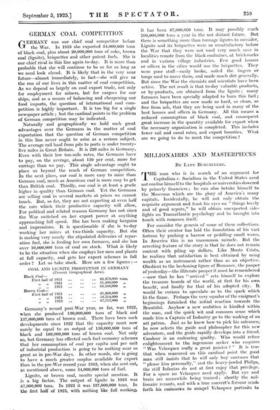GERMAN COAL COMPETITION
GERMANY was our chief coal competitor before the War. In 1913 she exported 34,000,000 tons of black coal, plus about 20,000,000 tons of coke, brown coal (lignite), briquettes and other patent fuels. She is our chief rival in this line again to-day. It is more than probable that she will continue to be so for as long as we need look ahead. It is likely that in the very near future—almost immediately, in fact—she will give us the run of our lives in this matter of coal competition. As we depend so largely on coal export trade, not only for employment for miners, but for cargoes for our ships, and as a means of balancing and cheapening our food imports, the question of international coal com- petition is highly important. It is too big for a single newspaper article ; but the cardinal points in the problem of German competition may be indicated.
Naturally and geographically we hold such great advantages over the Germans in the matter of coal exportation that the question of German competition in this. line never ought to arise as a serious subject. The average rail haul from pits to ports is under twenty- five miles in Great Britain. It is 220 miles in Germany. Even with their low ton-mile rates, the Germans have to pay, on the average, about 150 per cent. more for carriage than we pay. This single advantage ought to place us beyond the reach of German competition. In the next place, our coal is more easy to mine than German coal, much as American coal is more easy to get than British coal. Thirdly, our coal is at least a grade higher in quality than German coal. Yet the Germans are selling coal in several markets at prices we cannot touch. But, so far, they are not exporting at even half the rate which their productive capacity will allow. For political and related reasons Germany has not since the War switched on her export power at anything approaching full speed. She has been making bargains and impressions. It is questionable if she is to-day working her mines at two-thirds capacity. But she is making very nearly the stipulated deliveries of repar- ation fuel, she is feeding her own furnaces, and she has over 10,000,000 tons of coal on stock. What is likely to be the situation when she employs her men and plants at full capacity, and gets her export schemes in full order ? Let us take stock. Here are a few figures :- COAL AND LIGNITE PRODUCTION IN GERMANY (Present Geographical Area). Black Coal—
First half of 1913 ..
„ 1924 .
, „ 1925 .. Brown Coal—
First half of 1913 ..
,, 1924 . • „ „ 1925 ..
Germany's record post-War year, so far, was 1922, when she produced 130,000,000 tons of black and 137,000,000 tons of brown coal. There have been such developments since 1922 that the capacity must now surely be equal to an output of 150,000,000 tons of black and 180,000,000 tons of brown coal. Not only so, but Germany has effected such fuel economy schemes that her consumption of coal 'per capita and per unit of industrial production is going to be nothing near so great as in pre-War days. In other words, she is going to have a much greater surplus available for export than in the pre-War record year 1913, when she sent out, as mentioned above, some 54,000,000 tons of fuel.
Lignite, or brown coal, merits special mention. It is a big factor. The output of lignite in 1913 was 87,000,000 tons. In 1922 it was 187,000,000 tons. In the first half of 1925. with nothing like full working,
.. 6S,878,000 tons.
.. 51,498,000
.. 64,546,000 I*
.. 41,900,000
.. 58,314,000 .1 .. 67,112,000 /HI
• • • •
it has been 67,000,000 tons. It may possibly reach 200,000,000 tons a year in the not distant future. But there is something more than tonnage figures to consider. Lignite and its briquettes were so unsatisfactory before the War that they were not used very much save in localities remote from the black coalmines, at brickworks and in various village industries. Few good houses or offices in the cities would use the briquettes. They were poor stuff—easily broke, soiled the fingers or tongs used to move them, and made much dirt generally. But since the War the chemists and scientists have been active. The net result is that to-day valuable products, or by-products, are obtained from the lignite ; many furnaces have been specially adapted to burn this fuel ; and the briquettes are now made so hard, so clean, so free from ash, that they are being used in many of the best houses and offices in Germany. All this means a reduced consumption of black coal, and consequent great increase in the quantity available for export when the necessary organization is completed. This includes lower rail and canal rates, and export bounties. What are we going to do to meet the competition ?










































 Previous page
Previous page